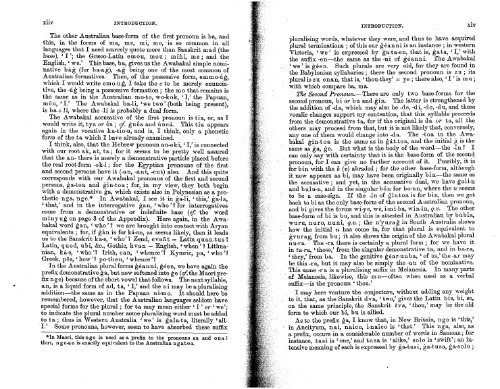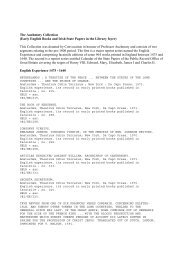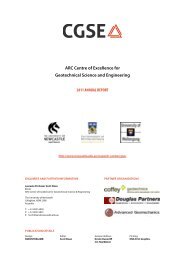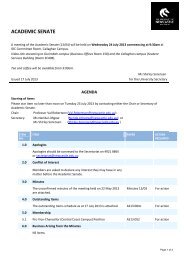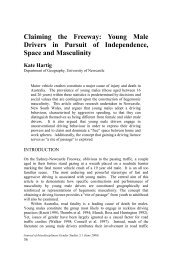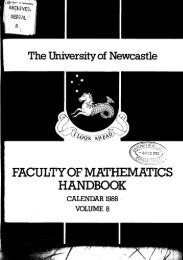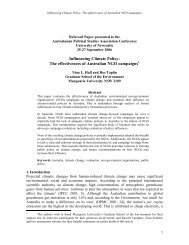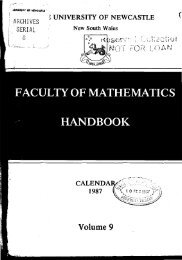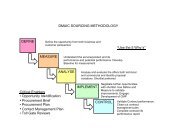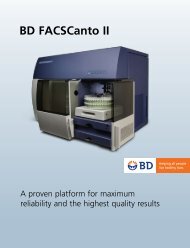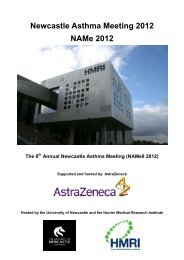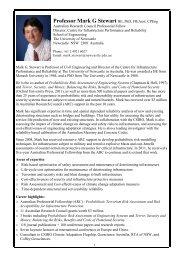n - University of Newcastle
n - University of Newcastle
n - University of Newcastle
Create successful ePaper yourself
Turn your PDF publications into a flip-book with our unique Google optimized e-Paper software.
xliv IXTEODCCTION.<br />
The other Australian base-form <strong>of</strong> the first pronoun is ba, and<br />
this, in the forms <strong>of</strong> ma, me, mi, nlo, is so comnlpn in all<br />
languages that I need scarcely quote more than Sanskrit mad (the<br />
base), ' I '; the Gmco-Latin emou, mou ; mihi, me ; and the<br />
English, ' we.' This base, ba, gives us the Awabakal simple nomi-<br />
native big (for ba-ag), -ag being one <strong>of</strong> the most comnlon <strong>of</strong><br />
Australian formatives. Then, <strong>of</strong> the possessive form, emm 0-6 g,<br />
which I would write emo-ng, I take the e to be merely enuncia-<br />
tive, the -fig being a possessive formation ; the mo that remains is<br />
the same as in the Australian mo-to, wo-kok, 'I,' the Papuan,<br />
mau, 'I.' The Awabakal ba-li, 'we two' (both being present),<br />
is ba + li, where the -1i is probably a dual form.<br />
The Awabakal accusative <strong>of</strong> the first pronoun is tia, or, as I<br />
would write it, tya or 6a ; cJ: gu6a and 6nci. This tia appears<br />
agin in the vocative ka-tio-u, and is, I think, only a phonetic<br />
form <strong>of</strong> the ta which I have already examined.<br />
I think, also, that the Hebrew pronoun an-oki, '1,'is connected<br />
with our root ak, at, ta; for it seems to be pretty well assured<br />
that the an- there is merely a demonstrative particle placed before<br />
the real root-form -ok-i ; for the Egyptian pronouns <strong>of</strong> the first<br />
and second persons have it (-an, -ant, -ent) also. And this quite<br />
corresponds with our Awabakal pronouns <strong>of</strong> the first and second<br />
persons, ga-toa and gin-toa; for, in my view, they both begin<br />
with a demonstrative ga, wluch exists also in Polynesian as a pro-<br />
thetic nga, nge." In Awabakal, I see it in gali, ' this,' ga-la,<br />
' that,' ancl in the interrogative gan, ' who ' ? for interrogatives<br />
come from a demonstrative or indefinite base (cJ: the word<br />
minyug on page 3 <strong>of</strong> the Appenclix). Here again, in the Awa-<br />
bakal word gan, ' who ' ? me are brought into contact with Aryan<br />
equivalents ; for, if gin is for kCan, as seems likely, then it leads<br />
us to the Sanskrit ka-s, ' who' ? Zend, cvaiit = Latin quan-tus ?<br />
Latin, quod, ubi, ~bc., Gothic, hvan = English, 'when'l Lithua-<br />
nian, k A-s, ' who '? Irish, can, ' whence '1 Kymric, pa, ' who '?<br />
Greek. piis, ' how '2 po-then, ' whence '?<br />
In the Australian plural forms gbanni, gden, we have again the<br />
prefix demonstrative ga, but now s<strong>of</strong>tened into ge (ef. the Maori pre-<br />
fix ngej because <strong>of</strong> the short vowel that follows. The next syllable,<br />
an, is a liquid form <strong>of</strong> ad, ta, ' I,' and the ni may be a pluralising<br />
addition-the same as in the Papuan ni-mo. It should here be<br />
remembered, however, that the Australian languages seldom have<br />
special forms for the plural ; for ta may mean either ' I ' or ' we1;<br />
to indicate the plural number some plnralising word must be added<br />
to ta ; thus in Wester11 Australia ' we ' is gala-ta, literally ' all-<br />
I.' Some pronouns, however, seem to have absorbed these suffix<br />
+In Maori, this nge is used as a prefix to the pronouns au and ona ;<br />
thus, nge-au is exactly equivalent to the Australian ngatoa.<br />
IFTBODUCTIOJ. X~Y<br />
iluralising words, whatever they were, ani thus to have acquired<br />
plural terminations ; <strong>of</strong> this our gdanni is an instance ; in western<br />
Victoria, ' we ' is expressed by ga-ta-en, that is, gata, ' I,' with<br />
the suffix -en-the same as the -ni <strong>of</strong> gbanni. The Awabakal<br />
. 'we ' is gben. Snch plurals are very old, for they are founclin<br />
the Babylonian syllabaries ; there the second pronoun is zu ; its<br />
plural is zu enan, that is, ' thou-they' = ye ; there also, ' I ' is mu ;<br />
with which compare ba, ma.<br />
Th Second A-o~zoz~~z.-There are only two base-forms for the<br />
second pronoun, bi or bu and gin. The latter is strengthenecl by<br />
the addition <strong>of</strong> -da, which may also be -cle, -di, -do, -clu, and these<br />
vocalic changes support my contention, that this syllable proceeds<br />
from the demonstrative ta, for if the origina1.i~ da ot. ta, all the<br />
others may proceed from that, but it is not likely that, conversely,<br />
any one <strong>of</strong> them would change into -cia. The -toa in the Amabikal<br />
gin-t oa is the same as in gihtoa, and the initial 6; is the<br />
same as ga, ge. But what is the body <strong>of</strong> the word-the -in ? I<br />
can only say with certainty that it is the base-form <strong>of</strong> the seconcl<br />
pronoun, for I can give no fnrther account <strong>of</strong> it. Possibly, it is<br />
for bin with the b (v) abraded ; for the other base-form, although<br />
it now appears as bi, may have been originally bin-the same as<br />
the accusative ; and yet, in the accusative clual, we have gali-n<br />
and bulu-n, and in the singular b6n for bo-nn, where the ?L seems<br />
to be a case-sign. If the -in <strong>of</strong> 6;intoa is for bin, then we get<br />
back to bias the only base-form <strong>of</strong> the second Australian pronoun,<br />
and bi gives the forms wi-y e, mB, i-mi-ba, vin-in, q.v. The other<br />
base-form <strong>of</strong> bi is bu, and this is attested in Australian by biubla,<br />
wuru, nuro, nuni, q.v. ; the n'yurag in South Australia shows<br />
. how the initial TL has conle in, for that plural is equivalent to<br />
' gvurag, from bu; it also shows the origin <strong>of</strong> the Awabakal plural<br />
nu-ra. The -ra there is certainly a plural form ; for me have it<br />
in ta-ra, 'those,' from the singular demonstrative ta, and in ba-m,<br />
' they,' from ba. In the genitive gbar-uuba, ' <strong>of</strong> us,' the -ar may<br />
be this -ra, but it may also be simply the -an <strong>of</strong> the nominative.<br />
This same -r a is a pluralising su& in Melanesia. In many parts<br />
<strong>of</strong> Melanesia, likewise, this mu-<strong>of</strong>ten when used as a verbal<br />
suffix-is the pronoun ' thou.'<br />
I may here venture the conjecture, nithoui adding any eight<br />
to it, that, as the Sanskrit dva, 'two,' gives the Latin bis, bi, so,<br />
on the same principle, the Sanskrit tva, ' thou,' may be the old<br />
form to which our bi, bu is allied.<br />
As to the prefix ga, I know that, in New Britain, ngo is 'this,'<br />
Aneityum, nai, naico, i-naico is 'that.' This nga, also, as<br />
refix, occurs in a considerable number <strong>of</strong> worcls in Samoan; for<br />
e, tasi is 'one,'and tusa is 'alike,' solo is 'swift'; an intensive<br />
meaning <strong>of</strong> each is expressed by ga-tasi, ga-tusa, ga-so10 ;


